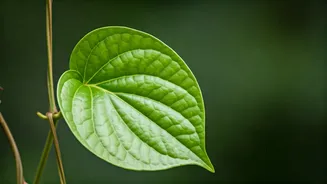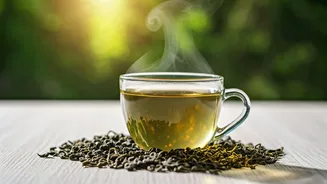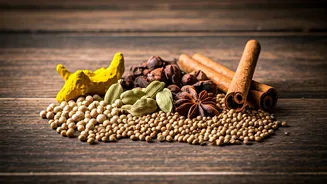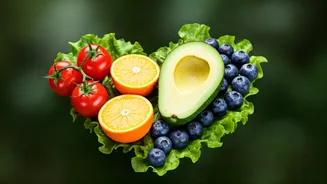A Cultural Icon
Betel leaves, scientifically known as Piper betle, have been an integral part of Indian traditions and customs for centuries. Their use transcends mere
consumption, symbolizing hospitality, auspiciousness, and respect. From ancient Vedic rituals to everyday social interactions, these leaves have played a vital role. In many Indian cultures, offering betel leaves and areca nuts is a gesture of welcome and reverence. They are essential in ceremonies, weddings, and religious practices. The preparation and presentation of paan vary across regions, reflecting the diverse culinary and cultural landscape of India. The tradition of paan reflects a deep connection to nature and a celebration of sensory experiences. Their continued presence highlights a timeless bond between people and nature.
Nutritional Powerhouse
Beyond their cultural significance, betel leaves are rich in nutrients and bioactive compounds that contribute to several health benefits. These leaves contain various vitamins, minerals, and antioxidants, including vitamin C, vitamin A, and tannins. These elements contribute to overall well-being. Studies indicate that betel leaves have antimicrobial, anti-inflammatory, and antioxidant properties. These qualities help protect the body against infections, reduce inflammation, and combat free radicals. The leaves also have essential oils that provide a unique aroma and flavor. These properties are often used for digestive support. Furthermore, they are a good source of fiber, which aids digestion. Regular consumption may provide diverse health advantages, making it a valuable addition to a balanced diet.
Oral Health Benefits
Betel leaves have long been used in traditional medicine to promote oral health. Their antimicrobial properties help combat harmful bacteria that cause dental problems such as cavities and gum disease. Chewing betel leaves can stimulate saliva production, which helps neutralize acids and protect teeth from decay. The leaves' natural compounds may also have an antiseptic effect, helping to freshen breath and maintain oral hygiene. Additionally, they may aid in reducing inflammation and promoting faster healing of oral tissues. The practice of chewing betel leaves is sometimes associated with a lower incidence of certain oral health problems, underscoring their role in maintaining healthy gums and teeth. The leaf's fibrous nature also helps to clean teeth naturally.
Blood Sugar Support
Research suggests that betel leaves may help regulate blood sugar levels. The leaves contain compounds that enhance insulin sensitivity, improving glucose uptake by cells. This can help to stabilize blood sugar levels and potentially reduce the risk of type 2 diabetes. Furthermore, betel leaves contain antioxidants, which combat oxidative stress. This stress can impact insulin function. Regular consumption of betel leaves, when part of a balanced diet, may help manage blood sugar, improving overall metabolic health. While more research is required to fully understand the effects, initial findings offer hope in managing this important area of health. These effects emphasize the potential role of betel leaves as a natural aid in blood sugar regulation.
Liver Protection
Betel leaves may play a role in protecting and supporting liver health. Studies indicate that they have hepatoprotective properties, meaning they can safeguard the liver from damage caused by toxins and free radicals. They aid in detoxifying the liver. The antioxidants in betel leaves help neutralize harmful substances. Additionally, betel leaves may help reduce inflammation in the liver. This effect supports overall liver function. These protective effects suggest that incorporating betel leaves into your diet may contribute to maintaining a healthy liver and reducing the risk of liver-related diseases. The protective actions of betel leaves highlight their potential role as a natural liver support.
Beyond Wellness: Rituals
The use of betel leaves extends beyond their medicinal properties and is interwoven with Indian cultural practices. They are commonly included in various religious ceremonies and rituals. Offering paan at weddings and festivals symbolizes prosperity, respect, and good fortune. Preparing paan is often a social activity, bringing families and communities together. The practice includes detailed preparation and artistry, from selecting the right leaves to adding flavorings. The traditions surrounding betel leaves represent India's rich heritage and cultural values. These traditions emphasize their importance in creating and maintaining social bonds, symbolizing hospitality, and acting as a symbol of good luck.










